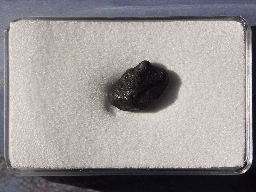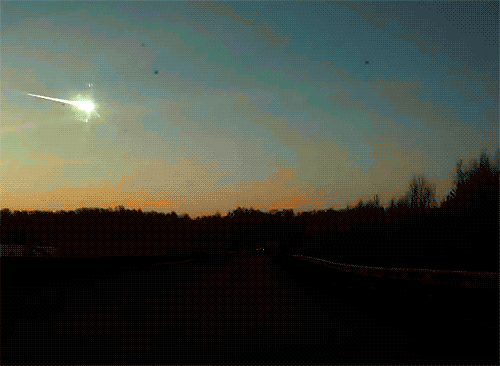The Chelyabinsk Meteorite
While I am mostly interested in the planets, I was keen to acquire a sample of the most famous and dramatic meteorite to have fallen for over a century - the Chelyabinsk meteorite of 15th February 2013. The next Christmas provided an excellent opportunity to do so!
 The Chelyabinsk meteorite was a small asteroid of the Earth-crossing Apollo type, and probably related to the larger asteroid bodies with the rather uninspiring names 1999 NC43 (asteroid number 86039) and 2011 EO40, the latter being the most likely candidate for its parent body. With an estimated initial mass of about 13,000 tons and measuring about 60ft in diameter, it is the largest known natural object to have entered Earth's atmosphere since the Tunguska event that destroyed a wide, remote, forested area of Siberia in 1908. It struck at about 41,000mph (almost 60 times the speed of sound) and quickly became a brilliant superbolide meteor over the southern Ural region of Russia, the light from which was brighter than the Sun. It then exploded in an air-burst at around 14.5mls high, generating a bright flash and producing many small fragmentary meteorites and a powerful shock wave which shattered thousands of windows and caused some structural damage. The montage above (taken by a car's dashboard camera) shows the meteor at 2sec intervals, illustrating its tremendous speed and capturing its explosion and subsequent fade. Note that the pinkish "trail" in the last image is the aftermath of the explosion: the meteorite itself is actually the dot close to the next lamp-post.
The Chelyabinsk meteorite was a small asteroid of the Earth-crossing Apollo type, and probably related to the larger asteroid bodies with the rather uninspiring names 1999 NC43 (asteroid number 86039) and 2011 EO40, the latter being the most likely candidate for its parent body. With an estimated initial mass of about 13,000 tons and measuring about 60ft in diameter, it is the largest known natural object to have entered Earth's atmosphere since the Tunguska event that destroyed a wide, remote, forested area of Siberia in 1908. It struck at about 41,000mph (almost 60 times the speed of sound) and quickly became a brilliant superbolide meteor over the southern Ural region of Russia, the light from which was brighter than the Sun. It then exploded in an air-burst at around 14.5mls high, generating a bright flash and producing many small fragmentary meteorites and a powerful shock wave which shattered thousands of windows and caused some structural damage. The montage above (taken by a car's dashboard camera) shows the meteor at 2sec intervals, illustrating its tremendous speed and capturing its explosion and subsequent fade. Note that the pinkish "trail" in the last image is the aftermath of the explosion: the meteorite itself is actually the dot close to the next lamp-post.
The panels below show some images of the meteorite fall (the phase when it was more accurately referred to as a meteor). The left-hand one is taken from an actual video of the event (but not by me, so it loops round rather faster than I would have done!). Click or tap on "Start" to set it going and then "Stop" to halt it. The right-hand panel is a film-strip of seventeen images of the fall, the trail left behind, the impact hole in Lake Chebarkul and some typical finds. Click or tap the forward and back arrows to scroll through the images. I think the one taken from the aircraft is particularly remarkable!
And finally we come on to my "personal meteorite"! The images show the two sides of my 1.3g sample, which is actually a self-contained "pebble" rather than a fragment of a larger object like the planetary meteorites displayed on the other page in this section. Its surface is essentially smooth, as a result of melting during its passage through the atmosphere, but still contains some dimples formed when the larger body disintegrated.

  |

  |
The Chelyabinsk meteorite is classified as a type LL5 ordinary chondrite, named after the "chondrules" (or spherical grains) they contain. LL stands for "Low iron, Low metal", meaning it is essentially a stony object, and the 5 means it has been modified by the effects of extreme heat so that its minerals are homogeneous in composition and the chondrule borders are difficult to discern (this happened when it was formed, not as a result of its encounter with the Earth). Ordinary chondrites are very common, with 6125 examples listed in the Meteoritical Database as of January 2014, of which 2888 were class LL5 (ranging from 408kg to a mere 0.1g). The total mass recovered after the explosion is difficult to estimate accurately but could well be greater than 1000kg (the largest piece being that recovered from Lake Chebarkul, at 654kg).
Click or tap on the arrows to move forwards and backwards through the images for each side: one taken with a normal lighting angle, then a closer view, then one taken with a shallow lighting angle (which brings out more detail), and again a closer look. For more information about the Chelyabinsk meteorite in general, click on the following links:-
|
 The Chelyabinsk meteorite was a small asteroid of the Earth-crossing Apollo type, and probably related to the larger asteroid bodies with the rather uninspiring names 1999 NC43 (asteroid number 86039) and 2011 EO40, the latter being the most likely candidate for its parent body. With an estimated initial mass of about 13,000 tons and measuring about 60ft in diameter, it is the largest known natural object to have entered Earth's atmosphere since the Tunguska event that destroyed a wide, remote, forested area of Siberia in 1908. It struck at about 41,000mph (almost 60 times the speed of sound) and quickly became a brilliant superbolide meteor over the southern Ural region of Russia, the light from which was brighter than the Sun. It then exploded in an air-burst at around 14.5mls high, generating a bright flash and producing many small fragmentary meteorites and a powerful shock wave which shattered thousands of windows and caused some structural damage. The montage above (taken by a car's dashboard camera) shows the meteor at 2sec intervals, illustrating its tremendous speed and capturing its explosion and subsequent fade. Note that the pinkish "trail" in the last image is the aftermath of the explosion: the meteorite itself is actually the dot close to the next lamp-post.
The Chelyabinsk meteorite was a small asteroid of the Earth-crossing Apollo type, and probably related to the larger asteroid bodies with the rather uninspiring names 1999 NC43 (asteroid number 86039) and 2011 EO40, the latter being the most likely candidate for its parent body. With an estimated initial mass of about 13,000 tons and measuring about 60ft in diameter, it is the largest known natural object to have entered Earth's atmosphere since the Tunguska event that destroyed a wide, remote, forested area of Siberia in 1908. It struck at about 41,000mph (almost 60 times the speed of sound) and quickly became a brilliant superbolide meteor over the southern Ural region of Russia, the light from which was brighter than the Sun. It then exploded in an air-burst at around 14.5mls high, generating a bright flash and producing many small fragmentary meteorites and a powerful shock wave which shattered thousands of windows and caused some structural damage. The montage above (taken by a car's dashboard camera) shows the meteor at 2sec intervals, illustrating its tremendous speed and capturing its explosion and subsequent fade. Note that the pinkish "trail" in the last image is the aftermath of the explosion: the meteorite itself is actually the dot close to the next lamp-post.


